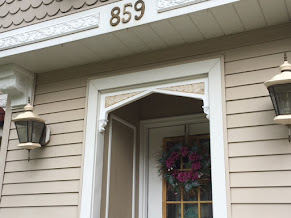While I'd expect the search for such items to be easier in the UK, it hasn't changed much in the U.S.--unless you want something custom-made or a very expensive antique.
Finally, last year I was able to do exactly that; custom-make a proper Tudor arch for the entry of our house, replacing the gingerbread scrolls that adorned the entry alcove for two-and-a-half decades. Since this had a southern exposure, and with maintenance in mind, I used 1-inch thick Azek board, backed with another inch of white pine, sandwiched together to provide the appropriate width for the small corbels on each side. As you may know, Azek is a PVC material that will last practically forever, never rot, and carves very much like wood. Also, since the trim is to be painted white anyway, it was an easy choice.
The arch panels were created to replace some wooden gingerbread (see photo) that has been there since the house was built. Looking through some old books, including a Dover reprint of Pugin's Gothic Ornament, I came up with a design, and once I had cut the arch form out with a jigsaw, set to carve it.
That took a couple of days. I also found some small brackets from Ekena which would serve to set off the arch nicely and make a nice base for each side to rest upon. Installation was pretty simple; the arch was pre-drilled on each side and at the backside--but it also helped to size it for a tight fit, so a few soft taps of a rubber mallet would hold it in place. Once set, the brackets were put in place on each side with adhesive and screws, the whole assembly was caulked and touched up with paint. Speaking of paint, the beige paint I used in the carved sections was wiped off the raised portions, to give a dry-brush effect that highlighted the carvings.
One other project I tackled during this time was to replace a couple of flower boxes that surround the concrete lions that grace the front porch. Like the gingerbread scrolls above the entry, the original boxes were a quick-solve; simply treated 2x4s that I had painted to match the house. After 20 years the screws (and some of the wood) had rotted, so I built some new ones out of cedar fence board and PVC trim, with some carved wood applique to tart them up a little. These get planted with red begonias every year, which love the sun and typically grow about halfway up the height of the lions by the end of July.






No comments:
Post a Comment